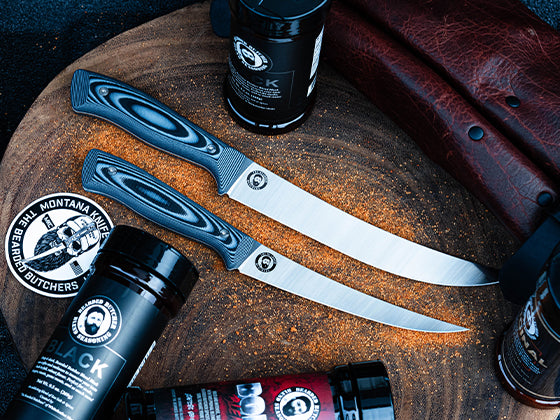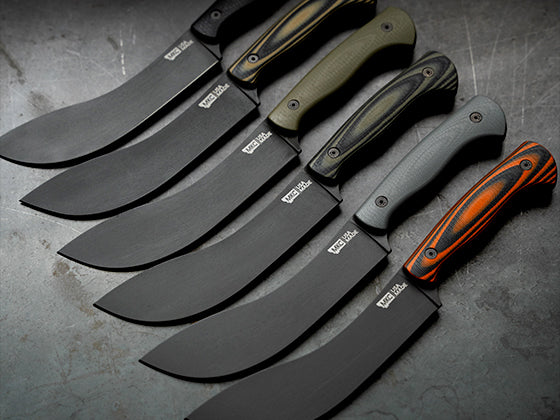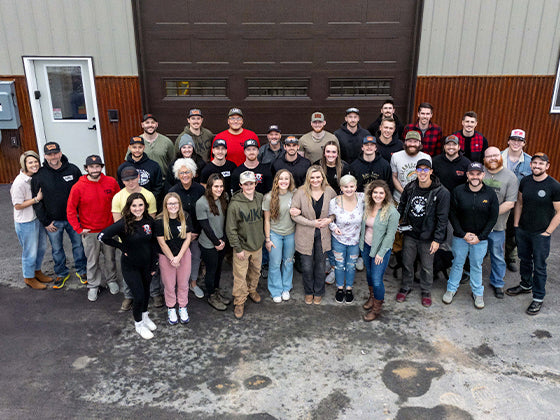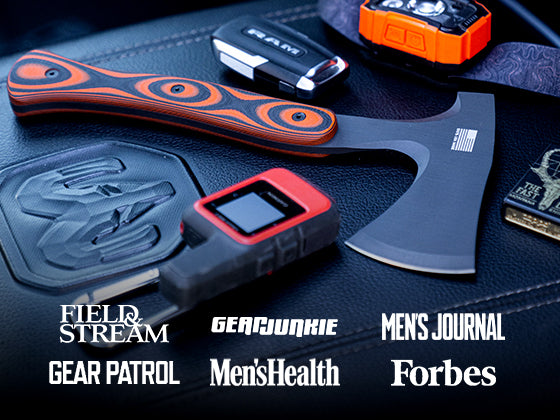There are five major “pillars” of good knife care. Follow them, and your knives will remain in good working condition for years to come.
These knife care tips apply to blades of any age. Whether your knife is a brand-new addition or a reliable old favorite, these tips will help you maintain its sharp working edge as long as possible.

Pillar 1: Work on a Cutting Board
The first pillar of kitchen knife care is to always work on a wooden cutting board.
Glass, stone, ceramic, and other hard surfaces destroy a knife over time, especially along the cutting edge. Hard-cutting surfaces blunt your knife’s steel, but a wooden board has enough softness and give to preserve that edge.
Kitchen knives may look smooth, but they have tiny micro-serrations along the cutting edge. Any time they contact something else, those micro-serrations bend, dull, and flatten. This bending and dulling happens naturally over time, but it occurs much faster if you don’t practice proper knife care and storage.
Pillar 2: Wash by Hand
The second pillar of kitchen knife care is to always wash your knife by hand.
Most people know dishwashers are bad for sharp knives, but they incorrectly attribute the reason to heat or moisture. While it’s true that water is never your knife’s friend, a brief stint in hot water won’t damage your blade.
What will damage the knife is all the other items in that dishwasher jostling around. Anything that bounces or bumps against your blade can dull its edge. This goes for glasses, bowls, utensils, and silverware. Even the wire rack your knife rests on can cause damage.
When you’re done using your knife, resist the temptation to toss it in the dishwasher. Washing by hand is the foundation of proper knife care.
Pillar 3: Store With Care
The third pillar of kitchen knife care is proper storage. This principle is the same as with dishwashers: you don’t want your knife to bump against anything that can damage it.
Kitchen drawers hold miscellaneous kitchen tools. The jostling of items in the drawer when you open and close it can damage your knife’s cutting edge.
Sometimes, the only space people have to store their knives is an overstuffed drawer. With this in mind, MKC includes a sheath with each kitchen knife to protect your blade from contact wear. But if your knife doesn’t have a sheath, the safest storage options are magnetic wall strips and wooden storage blocks.
Pillar 4: Perform Regular Maintenance
The fourth pillar of kitchen knife care is regular maintenance. This means using a honing rod or a coarse whetstone to realign those micro-serrations between sharpenings.
Sharpening your blade every time it gets dull is unnecessary, as sharpening creates an entirely new cutting edge with new micro-serrations. Often, your knife’s existing micro-serrations are still usable, just bent out of alignment.
Eventually, though, honing will no longer be enough to return your knife to its sharp state — that’s normal and natural. When that happens, it’s time to sharpen.
Pillar 5: Sharpen When Needed
The fifth pillar of kitchen knife care is sharpening. No matter how sturdy or well-cared-for your knife is, it’ll eventually lose enough micro-serrations to need sharpening.
All MKC knives are insured by the Generations Promise, meaning you can send them back for a free professional sharpening at any time in the blade’s life. You can also sharpen them yourself if you’d like, or hire a different professional.
If you send your knives to someone else, find a professional who understands the metallurgic side of knife sharpening. The friction of sharpening, grinding, and removing material from a blade creates heat.
The person sharpening your blade must be careful not to overheat the steel. Too much heat can warp or destroy a good blade. If that happens, the blade’s performance drops precipitously.
Caring for Different Knife Materials
While all knives require the same general maintenance, different knife materials sometimes need extra knife care. This concept applies not only to the blade itself but to other pieces of the knife, such as the sheath and handle.
Carbon Steel Knife Care
Carbon steel knives are more reactive than stainless steel blades. In particular, they’re extra weak to acid.
Take care to rinse your knife with clean water and wipe it dry after it comes into contact with acidic ingredients. Foods and condiments to watch out for include:
- Citrus fruits
- Onions
- Tomatoes
- Barbecue sauce, soy sauce, or steak sauce
- Cheese
- Fish
- Salty foods
Any knife benefits from regular protective oil or wax treatments. However, carbon steel especially loves the protection a good oiling provides. MKC’s food-grade Blade Wax is formulated with American beeswax, organic carnauba wax, fractionated coconut oil, lemon oil, and vitamin E oil to protect your blade.
MKC’s Blade Wax is a food-safe barrier that protects your blade against corrosion, rust, and dulling. A good blade wax or oil should be a staple of your knife care kit, regardless of whether your knives are made of carbon or stainless steel.
Your carbon steel knife will develop a natural blue-gray patina over time. This is a good thing — a natural patina protects your carbon steel blade from rust and corrosion. However, be careful not to mistake corrosion for patina, as rust is not a natural or desirable part of an aging knife.
Stainless Steel Knife Care
Stainless steel kitchen knives are low-maintenance and very durable. While stainless steel doesn’t react to acids the same way carbon steel does, it’s still important to keep your blade clean and dry.
MKC crafts its culinary knives with Magnacut stainless steel. This steel blend offers a razor-sharp, durable edge while retaining the non-reactive benefits of traditional stainless steel. The black Cerakote coating makes them durable and extra easy to clean.
Handle and Sheath Care
While MKC’s chef’s knives come with maintenance-free G10 handles, not all handle materials hold up well to abuse. Wood and leather, for example, require regular oiling and isolation from moisture.
Because they are weak to water, leather and wood components require a special cleaning process. Use a damp cloth to spot-clean any dirt, grime, blood, or hair from your blade. For extra cleaning power, use a wood- and leather-safe soap, such as oil soap. Dry promptly and treat with a good oil to maintain the quality of the wood or leather.
Ensure the inside of your leather sheath is fully cleaned and dry, as moisture can collect there. Never allow wood or leather to soak in water, as that can ruin the knife.
G10 plastic is the best handle material for any knife, whether you use it in the kitchen or out in the field. It’s sturdy, grippy, ergonomic, waterproof, and comes in enough colors to suit anyone’s taste.
Kydex sheaths are similarly maintenance-free. Kydex is a proprietary thermoplastic that makes fantastic sheaths and holsters. It’s waterproof, scratch-resistant, holds its shape, and cleans up easily. While MKC offers leather sheaths for those who prefer them, all MKC knives come with a custom-fitted Kydex holster.
Keep Your Knives Working for You
When you invest in a great knife, you want it to last a lifetime. These five pillars of kitchen knife care will keep your blades chopping and slicing like butter, no matter what you use them for.
by Mareko Maumasi, Master Bladesmith and Founder of Maumasi Fire Arts







































